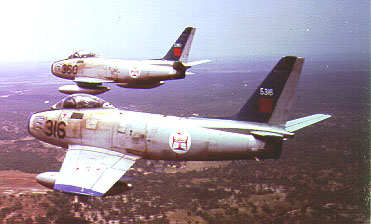

The F-86F was the fighter aircraft chosen by the M.D.A.P. (Military Defence Assistance Program) to equip the air defence component of the Portuguese Air Force (FAP) around the late fifties. At that time the aircraft still had a minimum of credibility having in mind Portugal’s position in Western Europe , at a considerable distance from the NATO/Warsaw Pact border.
In line with this decision, the Portuguese Air Force formed the
Esquadra 50 (Squadron) at Base Aérea 2 (Ota) in February
4,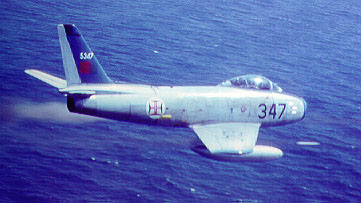 1958, with Captain Moura Pinto as the Commanding Officer. This was
the preparation phase for the activation of a new air base located in Monte
Real/Leiria in the center of the country, which was to be numbered
Base Aérea 5 (BA5).
1958, with Captain Moura Pinto as the Commanding Officer. This was
the preparation phase for the activation of a new air base located in Monte
Real/Leiria in the center of the country, which was to be numbered
Base Aérea 5 (BA5).
Immediately afterwards maintenance personnel started the aircraft
technical courses, and the pilots by groups of fifteen took four transformation
courses between March and June. From February until September pilots maintained
their flying training in the F-84.
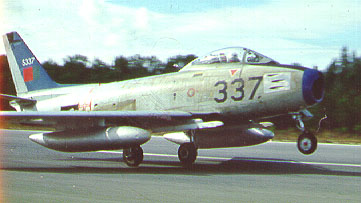 Some
sources refer that the F-86F began to arrive in July 1958, however flying
is recorded only from September. On the 11th of that month the squadron
number was changed to Esquadra 51 (ESQ51), due to the implementation
of a revised re-numbering system. A second squadron was also planned to
be created, the Esquadra 52 (ESQ52) forming with the previous one
the Fighter Group 501.
Some
sources refer that the F-86F began to arrive in July 1958, however flying
is recorded only from September. On the 11th of that month the squadron
number was changed to Esquadra 51 (ESQ51), due to the implementation
of a revised re-numbering system. A second squadron was also planned to
be created, the Esquadra 52 (ESQ52) forming with the previous one
the Fighter Group 501.
By the end of October 1958 a total of thirty aircraft had been received (5301-5308 and 5311-5332), and by September 1959 the second batch of thirty-four aircraft were delivered (5309-5310 and 5333-5363). However tail number 5344 was probably never applied to an aircraft, as no reliable records were found of any flights with this number.
The last two aircraft to enter service (5364-5365) arrived
only in November 1961. This means that 65 tail numbers were recorded
in the Air Force inventory. However, three F-86F were received additionally
never receiving any serial, because were assigned for spares only,
due to their actual condition.
As such a total of 68 aircraft were received. The details for
all the aircraft, including deliveries and dates when known, are presented
below.
The pilot flying rate was then established (February 1959) by the Air Chief of Staff : 15 hours per pilot/per month.
In August of the same year, due to the outstanding weaponry results,
Major Brochado de Miranda and 2º Sargento Cartaxo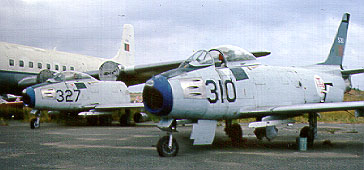 went to CAZAUX (France), as referees of a NATO (AIRCENT) air to air
shooting competition.
went to CAZAUX (France), as referees of a NATO (AIRCENT) air to air
shooting competition.
Finally on the 4th of October 1959, the Base Aérea 5 was officially inaugurated with an air show in which 16 F-86F performed several aerobatic figures.
By December 1959 almost all the pilots and aircraft had been definitely transferred to BA5, as well the support equipment. The air base was ready to accomplish it´s mission...
The Commanding Officers by January 1960 were:
Major Brochado de Miranda - Fighter Group 501 and ESQ52.
Cap Lemos Ferreira - ESQ 51
Cap Almeida Brito - Flying Safety Officer
Zoom and boom missions were at the beginning the most welcome,
because for the first time supersonic flight (Mach One) was possible over
Portugal using the new Air Force jets. Some damage on the ground
sometimes happened, and the respective pilots got in trouble.
In July 1960 the aircraft were assigned to the squadrons by tail number:
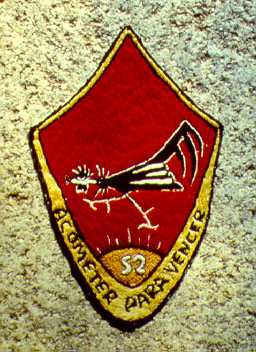 Esquadra
52 "Galos": fin, nose-band and wing-tips painted RED. We are not sure
how many of the aircraft listed below received the red colours, but the
following ones are the possibilities : 5334-35-36-38-39-40-41-42-43-45-46-48-50-51-52-53-54-56-57-58-59-62-63-64.
Esquadra
52 "Galos": fin, nose-band and wing-tips painted RED. We are not sure
how many of the aircraft listed below received the red colours, but the
following ones are the possibilities : 5334-35-36-38-39-40-41-42-43-45-46-48-50-51-52-53-54-56-57-58-59-62-63-64.
.
Esquadra 51 "Falcões": Painted BLUE: all the others.
Flying training was intensive and cross-country missions were mandatory for qualification. As such navigation flights to Spain, France, Denmark, Germany and Italy.
The air activity of those squadrons was remarkable and full operational capability was reached through national and foreign combined exercises in Portugal and all over Europe. The readiness of the aircrews and radar system operators was frequently tested with alert exercises which showed an high degree of accomplishment and standardization.
In 1961, there was an important change in the Fighter Group 501:
- The reassignment of a great number of pilots created a shortage
in personnel and the Esquadra 52 was disbanded on the 12th  June.
June.
- The activation of the "guerilla movements" in the Portuguese
Territories in África was the turning point in terms of training
for the Esquadra 51 squadron pilots. As such, air to ground which
was secondary, became the primary task for training, however air defence
role was always in the "heart of the Falcões" and remained the squadron
primary mission.
In the summer of 1961 a Detachment of eight F-86F Sabres was sent to Guiné-Bissau, in the so-called "Operation Atlas". The aircraft left Monte Real on August 8, making technical stops at Montijo Air Base (Portugal), Gando (Canary Islands) and Sal (Cabo Verde Islands). Aircraft numbers: 5307-14-22-26-54-56-61-62.
The Detachment 52, activated with eight aircraft at Bissalanca Air Base at Bissau, stayed until October 1964. Unfortunately, due to the pressure of the United States and other nations, they were forced to return to Portugal, because they were still NATO assigned aircraft. This created a difficult situation because the F-86F was the only jet available in the Air Force inventory besides the remaining F-84, which were already in the end of their active life. But this is another story...!
The Portuguese F-86F had an extensive employment in the war (Guiné-Bissau):577
sorties, being 430 operational missions, including ground attack
and close air support for the friendly forces, Army and Navy (Fuzileiros
- Portuguese Marines).
The losses were one aircraft (5314) destroyed in August
1962 by fire after an emergency landing with the bombs still hanging in
the pylons and finishing out of the runway, and one aircraft lost to enemy
action (5322) in May 1963, the pilot safely ejecting and being quickly
rescued. Some extensive damage was suffered by other aircraft due
to the Anti-Aircraft Artillery (AAA) fire.
We suspect that other tail numbers then the mentioned above served
in Guiné but only 5331 can be confirmed.
Between 1965 and 1967 several F-86F were stored in depot, and
as such were protected with an anti corrosive yellow  coating
. These aircraft stayed at Ota Air Base until 1975(?) when they were moved
to the Depósito Geral de Material da Força Aérea in
Alverca do Ribatejo (DGMFA). This military infrastructure has a runway
which serves also the Oficinas Gerais de Material Aeronautico (OGMA), a
maintenance compound belonging in the past (until 1994) to the Portuguese
Air Force.
coating
. These aircraft stayed at Ota Air Base until 1975(?) when they were moved
to the Depósito Geral de Material da Força Aérea in
Alverca do Ribatejo (DGMFA). This military infrastructure has a runway
which serves also the Oficinas Gerais de Material Aeronautico (OGMA), a
maintenance compound belonging in the past (until 1994) to the Portuguese
Air Force.
Tail numbers that were stored in the above conditions were.
5303 - 05 - 09 - 17 - 24 - 26 - 30 - 31 - 40 - 46 - 51 - 53 - 58 - 59 - 63 - 65
By July 1961 the squadron received five T-33 AN Silver Star (Canadair) for conversion of the pilots and dual flight training. The activity with this type of aircraft was maintained until 1970 (?).
For air to air, besides the six guns Browning Caliber 50, the Sidewinder missile (AIM-9B model) was used, and some sources indicated 420 as the number of missiles, all received in 1962.
As an example of the degree of activity, from October 1963 to October 1964, the aircraft of Esquadra 51 flew 3.123 hours with an average of 161 flying hours per combat ready pilot.
 Later,
in 1966 the Fiat G.91R/4 aircraft were assigned to the Esquadra 51.
As such this squadron became an operational conversion unit for this type
of aircraft, preparing pilots for war duties in Guiné-Bissau and
later, Moçambique and Angola.
Later,
in 1966 the Fiat G.91R/4 aircraft were assigned to the Esquadra 51.
As such this squadron became an operational conversion unit for this type
of aircraft, preparing pilots for war duties in Guiné-Bissau and
later, Moçambique and Angola.
In November 1974, a second squadron was transfered to Monte Real equipped with the T-33A T-Bird. The mission of this squadron, which received the designation of Esquadra 52 - Esquadra de Instrução Complementar de Aviões de Caça (EICPAC) , was advanced flying training for fighter pilots. For years this squadron "rebocou a manga"(towed the target) for air to air gunnery for the F-86F pilot training.
In 1977, the "PEACE TALON" program brought six T-38 Talon to Portugal. After the end of the program, in Setember of the same year, the aircraft were assigned to Esquadra 51, with the mission of providing a "fighter lead-in" type program and to convert pilots for the future F-5E TIGER II or F-4E squadron, which was expected to be formed two years later.
The decision of maintaining the T-38 fleet in Portugal was fully justified by the serious difficulties to guarantee the logistic support of the F-86F Sabre, which was expected to become impossible by April 1978 (twenty years after the arrival date). In effect, the availability of aircraft, since the beginning of 1978 was drastically reduced.
With the reorganization of the Portuguese Air Force in 1978, the Esquadra 51 became Esquadra 201, which together with the EICPAC, now re-named Esquadra 103, formed the Grupo Operacional 51 (GO51).
The Esquadra de Caça 201 (Fighter Squadron),
equipped with the T-38 and the F-86F (at this time the number of assigned
aircraft was 12 ), but waiting the replacement aircraft, which was
still under discussion, received the following missions:
Primary mission: Execution of Defensive and Offensive
Counter Air Operations:
- Interception
- Combat air patrol
- Air escort
Secondary mission: Execution of Offensive Air Operations
- Air Interdiction.
- Close Air Support
- Anti Surface Air Operations
In July, 1980 the last F-86F flight was made, when aircraft 5347
(Tenente Coronel Victor Silva) and 5360 (Capitão Roda)  took
off from BA5 at 14H45 and land at 16H10 after performing a farewell
flight around the Portuguese Air Bases and Radar Stations.
took
off from BA5 at 14H45 and land at 16H10 after performing a farewell
flight around the Portuguese Air Bases and Radar Stations.
No aerobatic teams were ever officially created with the F-86F.However numerous missions included aerobatic maneuvers performed at low altitude for pilot training and confidence.
The Esquadra 51/201 (Esquadra 52 had in effect a short live period
from January 1960 to June 1961) was the only air unit to operate the F-86F
Sabre in Portugal, being Monte Real air base, the Falcões Home Base.
The squadron motto: "Na Guerra ou Paz tanto nos faz", proudly honored and
respected by all pilots can be translated as "For War or Peace we are ready".
FALCÕES KILLED IN SERVICE - F-86F ACCIDENTS
2º Sargento Conceição Vitorino - 01 June 1960
- Carvide (5325).
Alferes Correia Barros - 14 November 1960 - Ansião (5323).
Alferes Rosa de Sousa - 12 November 1963 - Figueira da Foz (5343).
Capitão Amilcar Barbosa - 16 December 1970 - Alcochete
(5362).
Major Nazário Rodrigues - 13 January 1977 - São
Pedro de Muel (5308).
The air activity of the F-86F during the 22 years in service was around 60.000 flying hours and flown by 188 pilots.
The F-86F still in existence in the Portuguese Air Force are:
- 5301 - BA5 Monte
Real - Main gate.
- 5319 - On display
at the Air Museum in Alverca.
- 5320 - BA5 Monte
Real (display Air Museum)
- 5333 - DGMFA -
Alverca (Air Museum)
- 5337 - Ota
(Air Museum)
- 5338 - Ota (Air
Museum)
- 5347 - BA11 Beja
(display Air Museum).
- 5360 - DGMFA -
Alverca (Air Museum)
- 5361 - BA1
Sintra (display Air Museum).
The tail number 5316 was offered by The Portuguese
Air Force to the Brussels Air Museum.
Colour schemes and markings:
The F-86F were delivered in natural metal, and they did not receive any painting during their initial service. However the tail fin, wing tips and nose were painted dark blue in the Esquadra 51 and red in Esquadra 52. The photos show the dimension and position of this markings.

During 1968/69 all the operational aircraft received a coat of semi-gloss gray (equivalent to FS 16473), over the metallic surface. This scheme remained until the end of their lives. The type of Cross of Christ, as shown in the photos, was changed in the beginning of the sixties, also.
Aircraft list:
A list of all the aircraft received, with the details known is presented
below:
| Type as built | FAP | C/n | S/n USAF | S.oC.USAF | Initial
Flight with FAP |
T.o.C.FAP | End of
activity with FAP |
S.o.C.FAP | Remarks |
| F-86F-35 | 5301 | 191-864 | 52-5168 | 25/08/58 | 9/58 | 22/1/59 | 1/78 | 2/5/78 | At B.A.5 main gate |
| F-86F-35 | 5302 | 191-865 | 52-5169 | 13/10/58 | 9/58 | 18/3/59 | 6/67 | 23/7/69 | To OGMA as training material |
| F-86F-35 | 5303 | 191-867 | 52-5171 | 29/8/58 | 9/58 | 22/1/59 | 2/65 | 30/3/78 | Depot Ota (B.A.2).To scrap DGMFA 1977 |
| F-86F-35 | 5304 | 191-872 | 52-5176 | 22/9/58 | 9/58 | 22/1/59 | 5/60 | 24/6/63 | -- |
| F-86F-35 | 5305 | 191-874 | 52-5178 | 16/9/58 | 9/58 | 18/3/59 | 2/65 | 20/3/78 | Depot Ota (B.A.2).To scrap DGMFA 1977 |
| F-86F-35 | 5306 | 191-875 | 52-5179 | 11/10/58 | 9/58 | 19/3/59 | 3/65 | 8/11/66 | -- |
| F-86F-35 | 5307 | 191-876 | 52-5180 | 9/10/58 | 9/58 | 19/3/59 | 77/78 | 28/6/79 | Scrap DGMFA |
| F-86F-35 | 5308 | 191-879 | 52-5183 | 9/10/58 | 9/58 | 19/3/59 | 13/1/77 | 3/11/78 | Destroyed accident |
| F-86F-35 | 5309 | 191-885 | 52-5189 | 15/7/58 | 9/58 | 19/7/60 | 10/61 | 30/3/78 | Depot Ota (B.A.2).To scrap DGMFA 1977 |
| F-86F-35 | 5310 | 191-890 | 52-5194 | 30/7/58 | 9/58 | 19/7/60 | 8/75 | ? | Scrapyard Palhais Nov.96 |
| F-86F-35 | 5311 | 191-902 | 52-5206 | 7/10/58 | 9/58 | 22/1/59 | 7/61 | 9/2/64 | -- |
| F-86F-35 | 5312 | 191-903 | 52-5207 | 7/10/58 | 9/58 | 22/1/59 | 23/10/62 | 1/8/68 | Destroyed accident. |
| F-86F-35 | 5313 | 191-904 | 52-5208 | 7/10/58 | 9/58 | 22/1/59 | 2/65 | 29/11/66 | -- |
| F-86F-35 | 5314 | 191-906 | 52-5210 | 13/10/58 | 9/58 | 19/3/59 | 17/8/62 | 1/8/68 | Destroyed accident |
| F-86F-35 | 5315 | 191-936 | 52-5240 | 5/9/58 | 9/58 | 22/1/59 | 2/66 | 24/4/68 | -- |
| F-86F-35 | 5316 | 191-938 | 52-5242 | 29/8/58 | 9/58 | 22/1/59 | 7/80 | 29/9/81 | Presented to Brussels Air Museum |
| F-86F-35 | 5317 | 191-939 | 52-5243 | 25/8/58 | 9/58 | 22/1/59 | 2/65 | 30/3/78 | Depot Ota (B.A.2).To scrap DGMFA 1977 |
| F-86F-35 | 5318 | 191-950 | 52-5254 | 16/9/58 | 9/58 | 19/3/59 | 2/66 | 24/4/68 | -- |
| F-86F-35 | 5319 | 191-958 | 52-5262 | 11/9/58 | 9/58 | 22/1/59 | 12/77 | 14/6/78 | FAP Museum -Alverca |
| F-86F-35 | 5320 | 191-964 | 52-5268 | 11/9/58 | 9/58 | 22/1/59 | 4/80 | 28/9/81 | BA5 (Air Museum) |
| F-86F-35 | 5321 | 202-19 | 53-1090 | -- | 9/58 | 22/1/59 | 8/75 | 30/3/78 | Palhais scrapyard Nov.96 |
| F-86F-35 | 5322 | 202-26 | 53-1097 | -- | 9/58 | 22/1/59 | 31/5/63 | 5/12/66 | Destroyed. |
| F-86F-35 | 5323 | 202-83 | 53-1154 | -- | 9/58 | 22/1/59 | 14/11/60 | 1/5/61 | Destroyed accident |
| F-86F-35 | 5324 | 202-138 | 53-1209 | -- | 9/58 | 22/1/59 | 2/65 | 23/5/77 | Depot Ota (B.A.2).To scrap DGMFA 1977 |
| F-86F-35 | 5325 | 202-142 | 53-1213 | -- | 9/58 | 22/1/59 | 1/6/60 | 18/11/60 | Destroyed accident |
| F-86F-35 | 5326 | 191-866 | 52-5170 | 17/9/58 | 9/58 | 22/1/59 | 1/67 | 30/3/78 | Depot Ota (B.A.2).To scrap DGMFA 1977 |
| F-86F-35 | 5327 | 191-877 | 52-5181 | 17/9/58 | 9/58 | 22/1/59 | 7/75 | 2/4/79 | Palhais scrapyard Nov.96 |
| F-86F-35 | 5328 | 191-878 | 52-5182 | 12/9/58 | 9/58 | 22/1/59 | 1/75 | 2/4/79 | Scrapped DGMFA |
| F-86F-35 | 5329 | 191-897 | 52-5201 | 12/9/58 | 9/58 | 4/3/59 | 9/74 | 18/2/76 | Used for fire brigade training.at BA5 |
| F-86F-35 | 5330 | 191-901 | 52-5205 | 17/9/58 | 9/58 | 4/3/59 | 2/65 | 30/3/78 | Depot Ota (B.A.2).To scrap DGMFA 1977 |
| F-86F-35 | 5331 | 202-73 | 53-1144 | -- | 9/58 | 4/3/59 | 2/65 | 20/3/78 | Depot Ota (B.A.2).To scrap DGMFA 1977 |
| F-86F-35 | 5332 | 202-154 | 53-1225 | -- | 11/58 | 4/3/59 | ? | 8/11/66 | -- |
| F-86F-35 | 5333 | 191-880 | 52-5184 | 22/9/59 | 9/59 | 19/7/60 | 4/80 | 20/2/81 | DGMFA Alverca for FAP Air Museum |
| F-86F-35 | 5334 | 191-881 | 52-5185 | 5/11/59 | 3/61 | 19/7/60 | 12/66 | 2/3/67 | -- |
| F-86F-35 | 5335 | 191-893 | 52-5197 | 10/11/59 | 2/60 | 19/7/60 | 5/78 | 26/6/78 | Palhais scrapyard Nov.96. |
| F-86F-35 | 5336 | 191-894 | 52-5198 | 16/9/59 | 1/60 | 19/7/60 | 7/65 | 17/1/72 | OGMA .Scrap DGMFA |
| F-86F-35 | 5337 | 191-895 | 52-5199 | 19/11/59 | 9/59 | 19/7/60 | 6/80 | 28/9/81 | Ota (Air Museum) |
| F-86F-35 | 5338 | 191-900 | 52-5204 | 17/9/59 | 10/59 | 19/7/60 | ? | 8/8/78 | BA2 (Ota) for Air Museum |
| F-86F-35 | 5339 | 191-916 | 52-5220 | 29/9/59 | 10/59 | 19/7/60 | 1/78 | 10/1/79 | Palhais scrapyard Nov.96 |
| F-86F-35 | 5340 | 191-917 | 52-5221 | 10/11/59 | 1/60 | 19/7/60 | 10/67 | 30/3/78 | Depot Ota (B.A.2).To scrap DGMFA 1977 |
| F-86F-35 | 5341 | 191-948 | 52-5252 | 17/7/58 | 10/59 | 19/7/60 | 7/75 | 2/4/79 | Scrapyard DGMFA 1976..Palhais scrapyard Nov.96 |
| F-86F-35 | 5342 | 191-959 | 52-5263 | 24/9/59 | 10/59 | 19/7/60 | 4/774 | 28/1/76 | Destroyed accident |
| F-86F-35 | 5343 | 191-961 | 52-5265 | 6/8/59 | 10/59 | 19/7/60 | 12/11/63 | 10/7/64 | Destroyed accident |
| F-86F | 5344 | ? | ? | ? | ? | ? | ? | ? | See note 7 below |
| F-86F-35 | 5345 | 191-967 | 52-5271 | 12/11/59 | 1/60 | 19/7/60 | 14/3/62 | 19/10/62 | Destroyed accident |
| F-86F-35 | 5346 | 202-2 | 53-1073 | -- | 1/60 | -- | 5/66 | 30/3/78 | Depot Ota (B.A.2).To scrap DGMFA 1977 |
| F-86F-35 | 5347 | 202-12 | 53-1083 | -- | 2/60 | 19/7/60 | 7/80 | 28/9/81 | Stored at BA11 for FAP Air Museum. |
| F-86F-35 | 5348 | 202-21 | 53-1092 | -- | 9/59 | 19/7/60 | ? | 24/4/68 | -- |
| F-86F-35 | 5349 | 202-29 | 53-1100 | -- | 10/62 | 19/7/60 | 2/66 | 24/4/68 | -- |
| F-86F-35 | 5350 | 202-39 | 53-1110 | -- | 1/60 | 19/7/60 | 11/78 | 22/5/79 | Palhais scrapyard Nov.96 |
| F-86F-35 | 5351 | 202-44 | 53-1115 | -- | 9/59 | 19/7/60 | 6/64 | 30/3/78 | Depot Ota (B.A.2).To scrap DGMFA 1977 |
| F-86F-35 | 5352 | 202-45 | 53-1116 | -- | 1/60 | 19/7/60 | 10/66 | 24/4/68 | -- |
| F-86F-35 | 5353 | 202-63 | 53-1134 | -- | 9/59 | -- | 6/67 | 30/3/78 | Depot Ota (B.A.2).To scrap DGMFA 1977 |
| F-86F-35 | 5354 | 202-65 | 53-1136 | -- | 9/59 | 19/7/60 | 12/78 | 27/6/79 | Palhais scrapyard Nov.96 |
| F-86F-35 | 5355 | 202-81 | 53-1152 | -- | 1/60 | -- | 20/2/61 | 23/6/61 | Destroyed accident |
| F-86F-35 | 5356 | 202-85 | 53-1156 | -- | 1/60 | -- | 1/4/65 | 7/12/65 | Destroyed accident |
| F-86F-35 | 5357 | 202-93 | 53-1164 | -- | 9/60 | 19/7/60 | 8/75 | 10/1/79 | Palhais scrapyard Nov.96 |
| F-86F-35 | 5358 | 202-99 | 53-1170 | -- | 9/59 | 19/7/60 | 9/66 | 30/3/78 | Depot Ota (B.A.2).To scrap DGMFA 1977 |
| F-86F-35 | 5359 | 202-117 | 53-1188 | -- | 1/60 | 19/7/60 | 4/67 | 31/3/78 | Depot Ota (B.A.2).To scrap DGMFA 1977 |
| F-86F-35 | 5360 | 202-119 | 53-1190 | -- | 11/59 | 20/7/60 | 7/80 | 28/9/79 | Stored DGMFA for FAP Air Museum. |
| F-86F-35 | 5361 | 202-133 | 53-1204 | -- | 2/60 | 20/7/60 | 4/80 | 20/2/81 | Stored at BA1 for FAP Air Museum |
| F-86F-35 | 5362 | 202-152 | 53-1223 | -- | 9/60 | 19/7/60 | 16/12/70 | 19/5/72 | Destroyed accident |
| F-86F-35 | 5363 | 202-153 | 53-1224 | -- | 12/59 | 20/7/60 | 7/67 | 30/3/78 | Depot Ota (B.A.2).To scrap DGMFA 1977 |
| F-86F-30 | 5364 | 191-779 | 52-5083 | 6/7/61 | 12/61 | 20/11/61 | 4/78 | 3/11/78 | Palhais scrapyard Nov.96. |
| F-86F-30 | 5365 | 191-780 | 52-5084 | 6/7/61 | 11/61 | 6/12/61 | 1/67 | 30/3/78 | Depot Ota (B.A.2).To scrap DGMFA 1977 |
| F-86F-35 | -- | 52-5237 | -- | 10/68 | 4/12/69 | See text | |||
| F-86F-35 | -- | 53-1111 | -- | 10/68 | 4/12/69 | See text | |||
| F-86F-35 | -- | 53-1133 | -- | 10/68 | 4/12/69 | See text |
1 - S.o.C. -Struck of charge
2- Initial flight with FAP - All dates are confirmed by pilot
flight logs. It is possible, in some cases, that other flights were made
earlier, but no information is available.
2 - T.o.C. FAP - Taken on charge by FAP.This does
not mean the delivery date that must have ocurred between S.o.C USAF and
T.o.C. FAP
4- End of activity - Means last activity recorded,
mentioned in the documents available. In some cases it is not impossible
that other flights were made in later dates.
5- S.o.C FAP - The dates presented were taken from supply documents.
6 - The F-86F-35, unlike the the F-86F-30, was built with
the ability to carry under the port wing a 1,200 lb "special store"
( nuclear weapon).
7 - There are reasons to believe that number 5344 was never
used by any aircraft, even if the number was in assigned.
8 - To clarify the differences between the F-86F-30 and -35 a summary
is presented below:
8.1 - The following batches of F-86F-30 and -35 were built:
| North American designation | USAF designation | Quantity built | N.Americ.c/n's | USAF serials |
| NA-191 | F-86F-30 | 859 | 191-1 to 191-859 | 52-4305 to 52-5163 |
| NA-191 | F-86F-35 | 108 | 191-860 to 191-967 | 52-5164 to 52-5271 |
| NA-202 | F-86F-35 | 157 | 202-1 to 202-257 | 53-1072 to 53-1228 |
8.2 - The version -30 could be fitted with 3 pylons instead of 2, as in previous versions.
8.3 - The version -35 differed from the -30 , for being able to carry a nuclear weapon under the port wing, balanced by two drop tanks under the starboard wing.
8.4 - The so-called "6-3" wing was not connected directly to either -30 or -35 versions. This wing modification that consisted in taking out the slats, enlarging the root chord by 6 inches and the wing tip chord by 3 inches, besides the installation of a fence at 70% of the wingspan, was tested first in three -30 aircraft, already in service in USAF.
8.5 - This modification resulted from the needs of the Korean War, and was made at that time. Later on , not only the aircraft in the Korean theatre received the modification through the use of a kit, but also the modification was applied at the factory, from -30 nr.200 (52-4505), and subsequent aircraft, but also to all -35.
8.6 - As can be seen now in the table above, after correction of the mistake, all Portuguese F-86F were -35 except 5364 and 5365.
Bibliography:
a) Bordo de Ataque – by José Krus Abecasis - Coimbra Editora
1985
b) Several issues of “MAIS ALTO” the Portuguese Air Force magazine,
including an article by Gen.Barbeitos de Sousa in the issue of July/August
1989.
As a final note, and for those interested in knowing more in detail this fanmous aircraft,we recomend three books, among the many published:
a) The North American Sabre - Ray Wagner - Macdonald- London 1963 (which we consider the best)
b) F-86 Sabre - Maurice Allward - Ian Allan Ltd - London - 1978
c ) North American F-86 Sabre - Francis Bergése - Editions Ouest France - Rennes - 1983